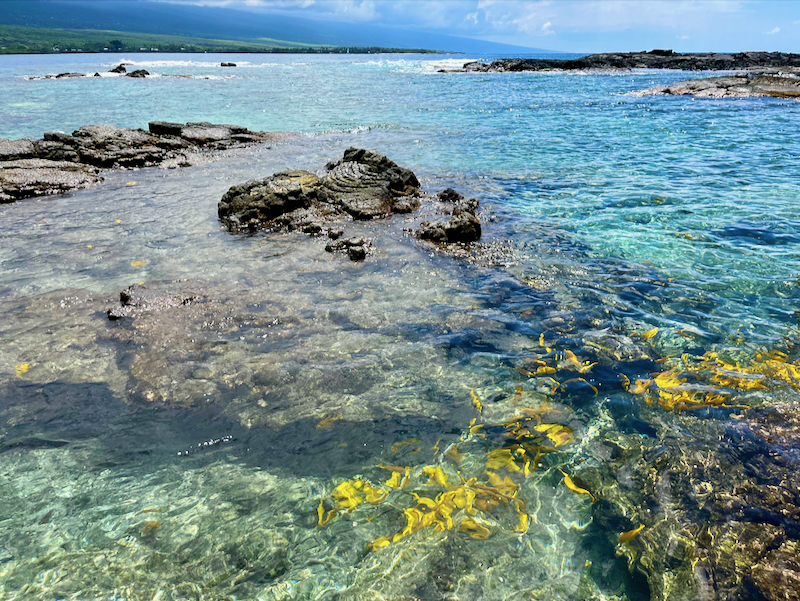Kealakekua Bay is one of the best snorkeling spots on the Big Island. One of the most adventurous ways to get there is by hiking the Captain Cook Monument Trail. Using a clear rating system, I share my honest review of the experience, along with firsthand tips.
Lists By Lukiih is readers-supported. When you buy with my affiliate link, I may earn a small commission. Thanks!
🍀 Lukiih’s Verdict
I highly recommend hiking the Captain Cook trail to snorkel in Kealakekua Bay when visiting the Big Island.
- Teeming with colorful tropical fish and marine life, Kealakekua Bay is one of the few places to spot spinner dolphins.
- If you hike to the bay, the experience is very affordable as you’ll only need to potentially pay for snorkeling gear.
- Minimal preparation is required, as you need to pack accordingly and prepare for the moderate hike.
🏆 Where Does It Rank?
Hiking Captain Cook to Kealakekua Bay ranks as the #4 experience I had in Hawaii. Here’s how it compares to other things I did on my trip:
My Maui and Big Island itineraries feature the above experiences.
✈️ About My Trip
For context on my review, here’s what to know about my trip:
- I finance my trips and don’t receive sponsorship; this review reflects my honest opinions.
- This post has updated 2024 information, but I did the Road to Hana in 2022.
- My Hawaii trip was in September when it was less crowded and expensive.
- Snorkeling in Kealakekua Bay is an uncommon experience. I estimate that fewer than 50 comparable snorkeling spots exist worldwide. It’s one of the most famous snorkeling sites in the world to see spinner dolphins, which are known for their acrobatic leaps out of water.
- Hiking the Captain Cook trail to the bay gives you access to a less crowded site teeming with fish. The site is also known to have monk seals and sea turtles. The fish near the bay’s entry point are also rather large. They’re not afraid to be near snorkelers, making the snorkeling experience quite memorable.
Part of the bay is protected by the Marine Life Conservation District, which prohibits activities such as fishing, feeding fish, and taking any coral or sand.
- Other snorkeling sites with spinner dolphins existed worldwide, including the Maldives, Bahamas, and Mauritius.
- I personally didn’t see any spinner dolphins, so my experience was not as memorable as it could have been.
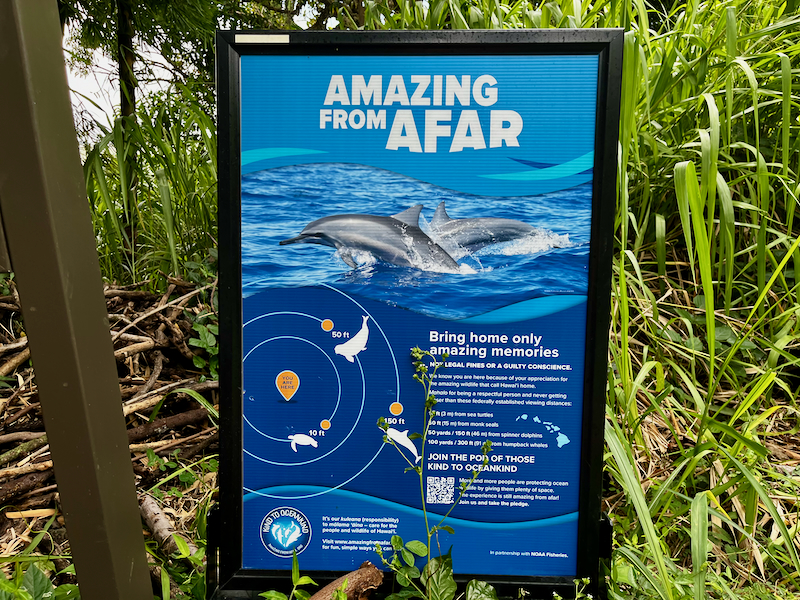
- It’s the best snorkeling spot I’ve been to in Hawaii because there are a ton of colorful fish near the entry point.
- The snorkeling site by the trail was not crowded where I went, which increased my enjoyment.
- Accessing the bay from the trail is somewhat rewarding because the hike is not easy.
- The Captain Cook trail is not a pleasant hike. Most people only hike it to access the bay’s gorgeous snorkeling site on the north side for free.

The Captain Cook Monument Trail and Kealakekua Bay do not have parking or entrance fees, so it’s free.
If you prefer to skip the hike and access the bay on a boat, you can book a snorkeling tour.
See my Hawaii trip expenses.
- You should know how to snorkel and be comfortable with some of the steeper sections of the trail.
- The Captain Cook Monument Trail and Kealakekua Bay are on the west side of the Big Island. You can Uber or drive a basic rental car to the trailhead. Driving to the trailhead takes 15 minutes to over an hour, depending on where you’re coming from on the island.
- This experience requires no advanced reservation unless you want to book a snorkeling tour. Make sure to dress and pack accordingly for hiking and snorkeling.
How To Guide & Tips
Interested in hiking Captain Cook to Kealakekua Bay after reading my review? Below is a practical how-to guide and firsthand tips.
Is There Parking
There is no official parking area for the Captain Cook trail. However, there are about 15 parking spots on the side of Napoopoo Road near the trailhead.
Given the limited parking, aim to arrive early (before 9 am) if you’re visiting during Hawaii’s peak season, which runs from mid-December to April.
I traveled to the Hawaiian islands in September during the low season. I got one of the last few spots near the trailhead when I arrived at 9:15 am.
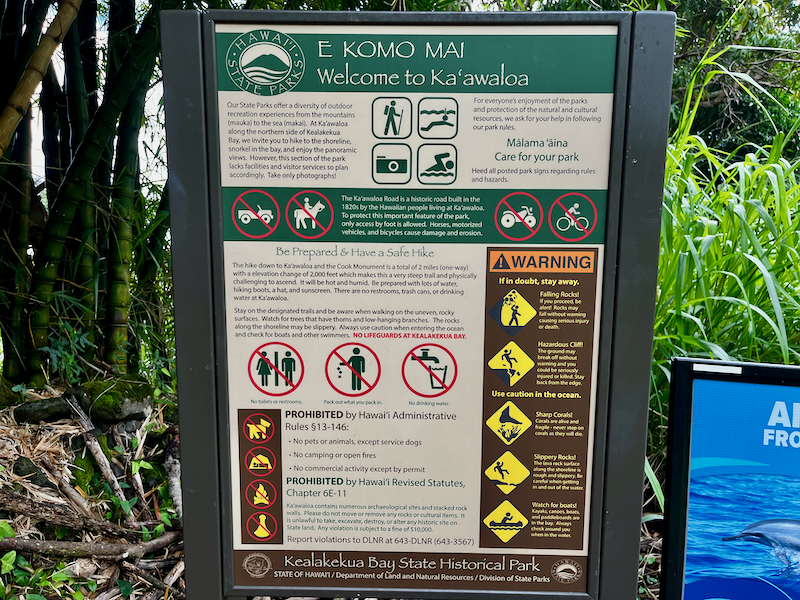
What’s The Trail Like
The Captain Cook Monument Trail, also called the Ka’awaloa Trail, is moderately challenging.
- Length: 4 miles, out-and-back
- Elevation gain: 1,272 feet
- Duration: ~2.5 hours to complete. I’m a decently strong hiker, and it took me about an hour each way.
If you’re hiking the trail to snorkel in Kealakekua Bay, plan on spending 5 to 6 hours total on the hike and snorkeling.
Here’s what you can expect on the hike:
- 🌿 Overgrown grass – During the first mile, you’ll be on a narrow dirt road surrounded by tall grass (some of my hiking buddies got a few itchy micro cuts and annoying welts).
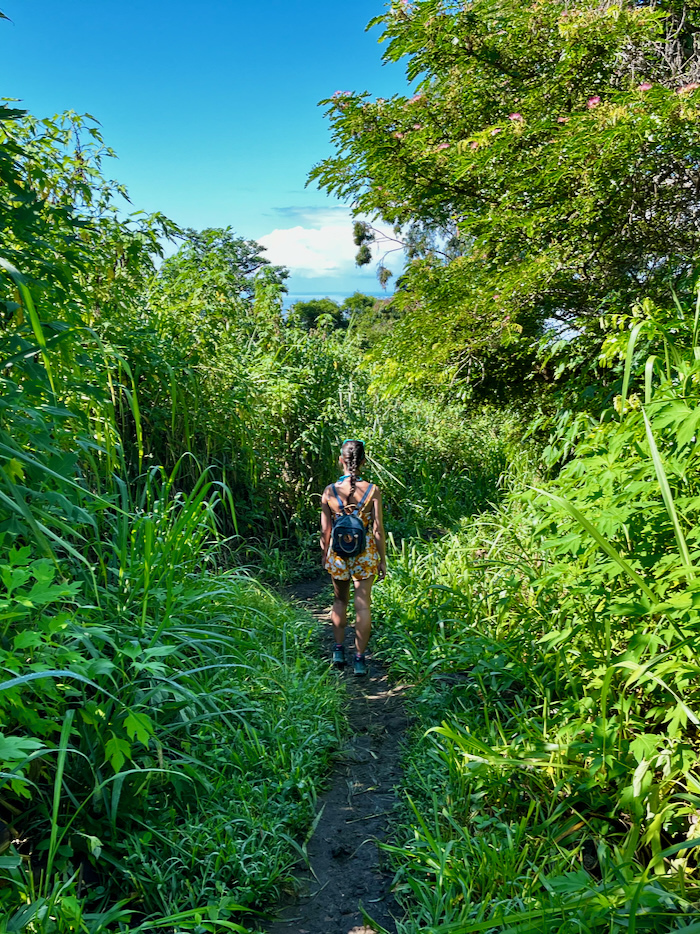
- 🥾 Steep descent – During the second half of the hike, you’ll reach a steep descent mostly comprised of loose rocks.
- ☀️ No shade – Some significant areas of the hike are completely exposed with no shade.
Are There Facilities
The Captain Cook hike and the north end of Kealakekua Bay have no facilities:
- 💧 Water fountains – no
- 🚽 Public bathrooms – no
- 🍉 Food vendors – no
Make sure to bring plenty of water to sustain yourself for both the snorkeling and return hike. I carried my 24 oz reusable water bottle that kept my water cold for hours.
Best Areas to Snorkel
Kealakekua Bay has a north and south snorkeling site:
- South end (see red circle below) – This is near Manini Beach and accessible by car. It has decent snorkeling, and several tour companies offer water activities like kayaking, surfing, and stand-up paddleboarding.
- North end (see orange circle below) – This is the better snorkeling spot and can only be accessed by kayaking, taking a boat tour from Keauhou Bay, or hiking the Captain Cook Trail (purple line below).
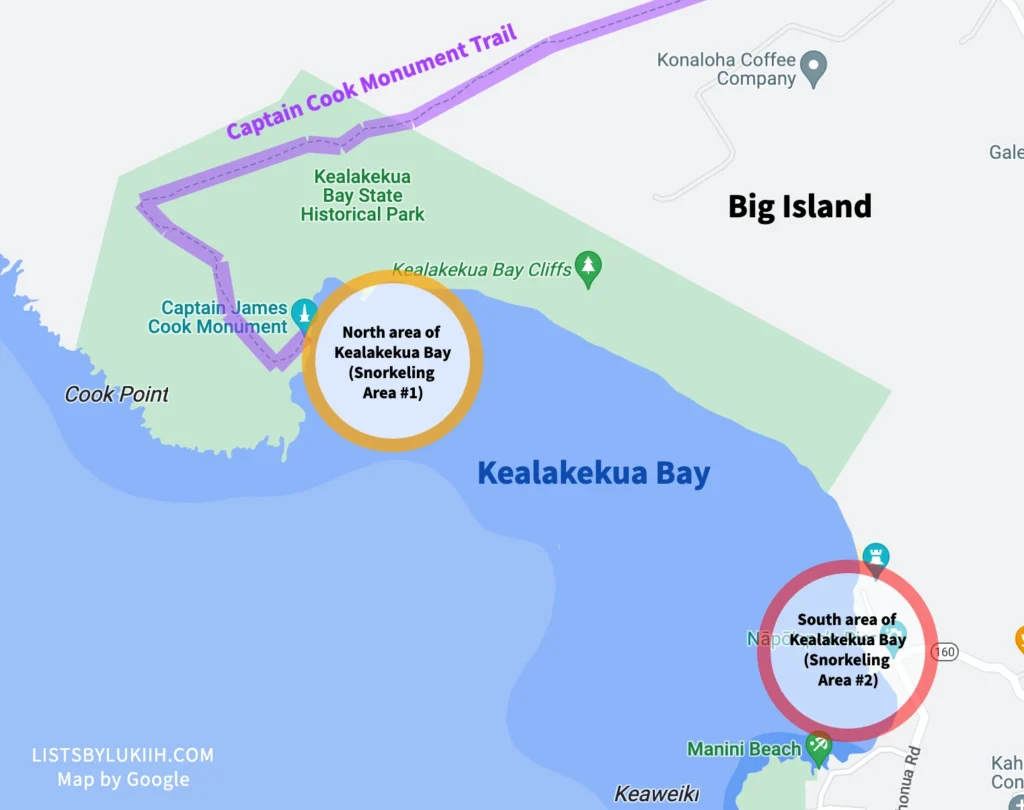
The north end has two snorkeling entry points:
- At the monument – The “official” snorkeling spot is where the Captain James Cook Monument is located.
- 👍🏻 Pros: Getting into the water from this entry point is more accessible; it has a nice step on the side. This area is also deeper, so you can potentially spot a sea turtle or dolphin from afar.
- 👎🏻 Cons: The water is less clear with fewer fish. It is also more crowded as it’s a popular spot for snorkelers and scuba divers coming in from boat tours.
- Off-trail – The unofficial spot is located here.
- 👍🏻 Pros: The water is very clear, and there are more fish. It’s also less crowded because it’s too shallow for scuba divers and boat tours to enter.
- 👎🏻 Cons: It’s more challenging and less safe to get into the water from this spot because of the spikey sea urchins and slippery rocks. Enter at your own risk.
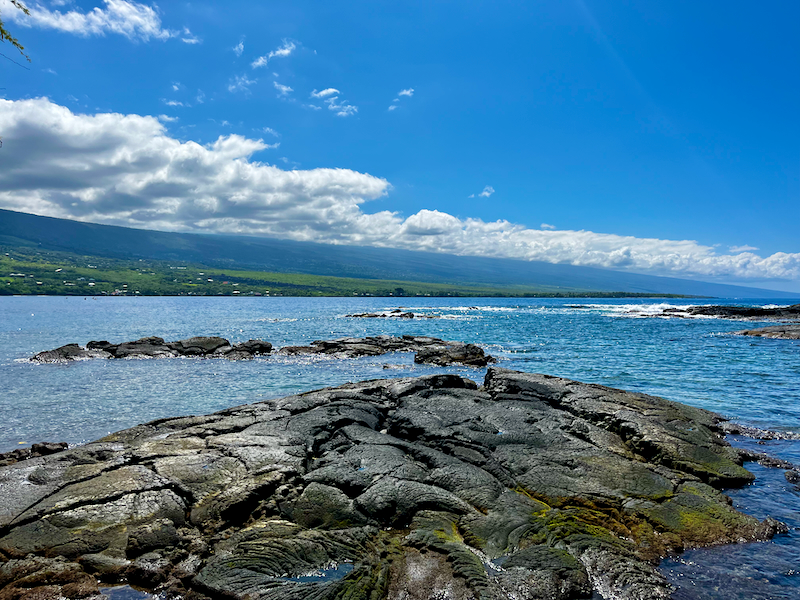
How To Stay Safe
There are some safety tips to be aware of when snorkeling at Kealakekua Bay from the Captain Cook side:
- Watch out for sea urchins – Sea urchins have venomous spikes that can puncture your skin and cause an inflammatory reaction. There are many of them near the off-trail entry point.
- Watch out for slippery rocks – Be careful, as the rocks are very slippery when getting in and out of the water (one of my hiking buddies fell while trying to enter the water).
- There are no lifeguards – Be aware that the bay has no lifeguards. Don’t go too far from the shore if you’re not a particularly strong swimmer.
- Watch out for Indian mongoose – There are aggressive Indian mongooses around the shores that seem to know that snorkelers have food. Make sure your food is sealed and placed in an area where it can’t be easily reached.
- Don’t step on corals – Corals can look like rocks, but they are alive and considered animals. Even a slight touch can harm the coral, and it can take years to recover, making it extremely important to not step on any coral.
What To Pack
Whether you’re hiking, jumping into a swimming hole, enjoying the beach, or mostly checking out some great views, here’s what to pack on the Road to Hana:
- Swimsuit
- Snorkeling gear
- Closed-toe shoes – I was glad to wear closed-toe shoes with some ankle support for the steeper portions with loose rocks. I saw locals hiking in flip-flops who seemed comfortable. I also saw two hikers in sandals who struggled around the rocky area.
- Water – Bring plenty of water (I brought a 24 oz reusable water bottle). There are no water fountains along the hike.
- Reef-safe sunscreens – Protect the corals in the bay. I like this reef-safe sunscreen because it spreads more easily than other alternatives I’ve tried.
- Long sleeves and loose pants (optional) – If you’re sensitive to grass or other plants, know you’ll be brushing against tall grass during the first mile.
Big Island Trip Planner 2024
To make your travel preparation easier, download the trip planner below. It has destination-specific travel information, itinerary, map, and packing list.
My trip planners are built on Notion, which I use for all my travel planning. I genuinely love this tool and creating an account is free.
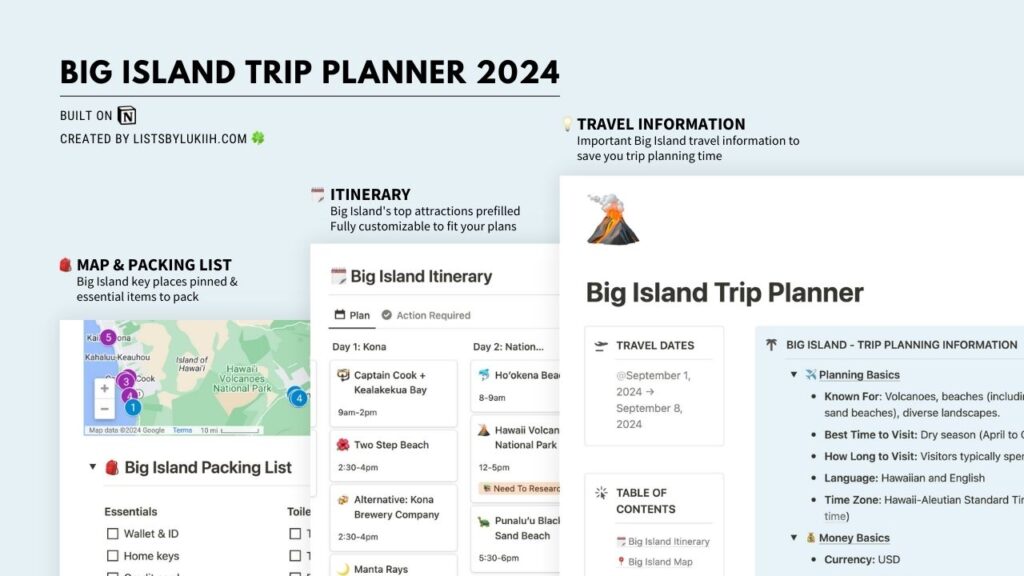
Hawaii Travel Guides
- 🏝️ Maui Amazing 5-Day Itinerary + Great Things To Do
- 🌋 Big Island: 3-4 Day Itinerary + 10 Great Things To Do
- 💰 My 2024 Hawaii Trip Cost: A Budget Breakdown
- ☀️ Haleakalā Sunrise: My Honest Review & Tips
- 🤿 Captain Cook Hike to Kealakekua Bay: My Honest Review & Tips
- 🚗 Road to Hana: My Honest Review & Tips
🧋 Support Lukiih
Lists by Lukiih is a humble website that I fund with my own savings. If you find my tips helpful, I appreciate you saying thanks with a bubble tea!
